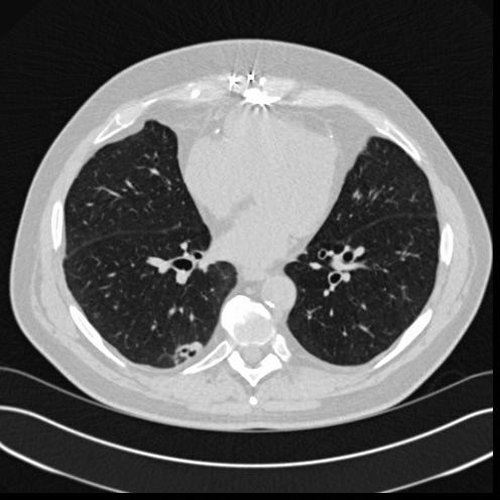Helical CT scans reduce lung cancer mortality by 20% compared to chest X-rays
Helical CT scans reduce lung cancer mortality by 20% compared to chest X-rays
A national study of more than 53,000 current and former heavy smokers has demonstrated that helical CT scanning reduced lung cancer deaths by 20 percent compared to using chest X-rays. Constantine Gatsonis and colleagues at Brown’s Center for Statistical Sciences contributed methodologic expertise and leadership throughout the study, which began in August 2002.

A better way to screen Computed tomography examines the lungs from many perspectives. It reduced lung cancer deaths by 20 percent compared to using chest X-rays in a major national study. Credit: ACRIN
PROVIDENCE, R.I. [Brown University] — In a major new study announced today by the National Cancer Institute, researchers including Brown University biostatistian Constantine Gatsonis and his colleagues found that screening for lung cancer using helical CT scanning reduced lung cancer deaths by 20 percent compared to using chest X-rays.
“The findings we’re announcing today offer the first definitive evidence for the effectiveness of helical CT screening smokers for lung cancer ” said Gatsonis, a lead biostatistician in the study and director of the American College of Radiology Imaging Network’s (ACRIN) Biostatistics and Data Management Center, based at Brown’s Center for Statistical Sciences. “This is a major step in the formulation of appropriate screening strategies for this deadly disease.”
The National Lung Screening Trial (NLST) was conducted by a consortium consisting of ACRIN and the Lung Screening Study (LSS). The consortium enrolled more than 53,000 current and former heavy smokers ages 55 to 74 into the NLST at 33 sites across the United States. Starting in August 2002, participants were enrolled during a 20-month period and randomly assigned to receive three annual screens with either low-dose helical CT (often referred to as spiral CT) or standard chest X-ray. A manuscript reporting on the design of the study appeared yesterday on the Web site of the journal Radiology.
“Everyone who participated in this trial has played an important role in providing hard evidence of a mortality benefit from CT screening for lung cancer as well as a road map for public policy development in the future,” said Denise R. Aberle, M.D., the national principal investigator for NLST ACRIN, site co-principal investigator for the UCLA NLST team, and a deputy chair of ACRIN.
Helical CT uses X-rays to obtain a multiple-image scan of the entire chest compared to a standard chest X-ray that produces a single image of the whole chest in which anatomic structures overlie one another.
A secondary finding in the study showed overall deaths due to any factor, including lung cancer, were 7 percent lower in those screened with low-dose helical CT than in those screened with chest X-ray. Approximately 25 percent of deaths in the NLST were due to lung cancer, while other deaths were due to factors such as cardiovascular disease.
“The combined findings of a reduction in mortality due to lung cancer and in overall mortality are important for the overall interpretation and impact of the results from this study,” Gatsonis said.
Today’s announcement addresses only the primary objective of the NLST study: the lung cancer mortality comparison between helical CT and chest X-rays. Intensive analysis of the data collected in the study is now under way to address a host of questions, including the health care required to follow up screening findings, the impact of screening on quality of life, and the cost and cost-effectiveness of screening for lung cancer, Gatsonis said. The results of these analyses will provide crucial information for the eventual development of guidelines for screening for lung cancer.
Faculty and staff at the Brown Center for Statistical Sciences contributed methodologic expertise and leadership throughout the study, in collaboration with other ACRIN and LSS investigators, Gatsonis said. They collaborated on the original design and implementation of the study, worked on the collection and monitoring of the data, and prepared in-depth reports for the independent Data and Safety Monitoring Committee. Now they are doing the final analysis of the data and contributing to the interpretation of the findings.
Faculty and staff at the center also organized and carried out the data collection on the impact of screening on quality of life and smoking cessation. Ilana Gareen, research assistant professor of community health, is leading this effort.
“Many, many people across the country dedicated years of their lives to bring this study to its successful conclusion,” Gatsonis said. “They should take pride in the results of their efforts announced today.”
The National Cancer Institute has additional information online about the study:
Questions and answers: www.cancer.gov/newscenter/qa/2002/nlstqaQA
Study fact sheet: www.cancer.gov/newscenter/pressreleases/NLSTFastFacts
* The above story is reprinted from materials provided by Brown University
** More information at Brown University (Providence, Rhode Island, USA)


















